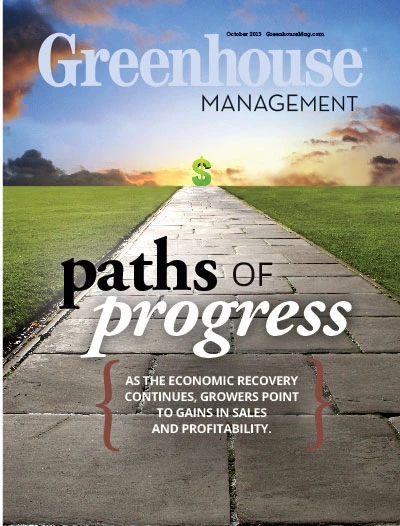 Green industry companies will find the economy providing enough support for them to make progress, but 2014 will not be strong enough to bail out poorly managed operations. The local economy is important to everyone, and local economies will continue to be quite varied. However, the largest driving force in most communities will be the national economy. In this article, we’ll start with that perspective, then turn to how the green industry can monitor local markets and develop contingency plans for economic uncertainty.
Green industry companies will find the economy providing enough support for them to make progress, but 2014 will not be strong enough to bail out poorly managed operations. The local economy is important to everyone, and local economies will continue to be quite varied. However, the largest driving force in most communities will be the national economy. In this article, we’ll start with that perspective, then turn to how the green industry can monitor local markets and develop contingency plans for economic uncertainty.
Hole in the road
The recession was like a man walking down the street and falling into a deep hole. The falling down period lasted about a year and a half. Then another two years were spent climbing out of the hole. When the poor fellow was finally back up to street level, not only was he dirty and shaken up, but he was three blocks away from where he would have been if he had been able to keep walking instead of going down and up the hole. Now the guy is shuffling along, not able to regain his normal stride. He’s moving in the right direction, but not as fast as he usually walks. As a result, he’s not catching up with his original schedule. We economists say that the country is out of recession, but nobody feels good about the economy now.
Consumers are increasing their spending, but only in pace with their incomes. There have been times when consumers were very optimistic and spent in anticipation of rising income or wealth – but not now. There have also been times when consumers were frightened and cut back their expenditures despite rising incomes – but not now. Instead, they are advancing cautiously. Be wary of media reports that “the consumer is tapped out” or “the consumer has too much debt.” Instead, recognize the wide variety of people out there. Some have jobs, some don’t.
Some have too much debt, while others own their cars and even their homes free and clear. Some have low wage jobs, but others are making good money. Green industry firms do not need everybody to be doing well, so long as a fair portion of the population is doing well, and that’s the case today.
Housing starts help
New residential construction has been the brightest part of the economy in the past year – good news for growers who sell to contractors, IGCs and big-box stores. Housing starts peaked at about 2 million units per year, then dropped to half a million units. Now we are on pace for nearly one million starts in 2013.
Next year should be even better. New construction will not regain the old peak level, at least not in my lifetime, but better days are clearly ahead. Mortgage rates are still low, though not quite as low as in the spring. More importantly, those years of very low construction left us in need of new housing.
Non-residential construction, in contrast, will remain fairly tame through 2014. Vacancy rates are still high, though edging down. Rents are just starting to increase. In this environment, few new projects pencil out. Usually, speculative developers would see a need for new buildings a few years out. Today, some see the need, but few can get financing. As a result, we are underbuilding relative to our long-run commercial property demand.
In the meantime, property owners are just beginning to enjoy stronger returns. The small increase in occupancy, along with the small increase in rents, brings revenue up without much increase in expense.
In 2014 some property owners who had been keeping their maintenance costs at bare bones levels will decide to spruce up their properties for competitive advantage. Green-industry companies who make sales calls at the right time may well reap the benefits of increased maintenance spending.
Looming labor questions
Sales potential in the horticulture industry is moderately positive, but labor costs are a substantial unknown. The trend for wage rates has been growth at about 2 percent per year. The economy won’t grow fast enough to put more upward pressure on wages, but politics could well change total labor cost.
The Affordable Care Act throws a monkey wrench into business labor plans. Small businesses are working hard to keep their full-time headcount to less than 50 employees, with full-time defined as 30 hours per week. Although the business mandate to provide care has been delayed, its implementation uses a one-year “look-back,” so employer statistics in 2014 will drive the health care mandate in 2015.
It’s likely that those employers willing to offer full time work can get good labor at a favorable wage rate. But the individual mandate to buy healthcare coverage may make workers feel a little poorer and less willing to accept a job without benefits.
As if health care law is not confusing enough, policies toward immigrant workers are also in a state of flux. Mandatory E-Verify usage may well spread. Many employers find that workers with paper documents don’t care to be scrutinized by the electronic system. The future of E-Verify is caught up in the political controversy over immigration policy. There’s no sure forecast for the future of employment costs, but increases seem more likely than not.
The small and large stage
Small businesses with bank credit lines will find that interest rates remain low. The cost of financing trucks may edge up a little. However, the many companies without bank loans will continue to find that credit standards are fairly high.
The local communities across the country will generally feel the effects of these national trends, but some differences are worth noting. The oil patch will see less new drilling activity than in the recent boom. Conditions will still be good, there, but not quite as spectacular as before.
Areas of the country with strong export businesses will see less growth than in past years, due to Europe’s continuing recession as well as slower growth in Asia. China and its neighbors are certainly not going into recession, but their rate of gain is not what it used to be. Agriculture communities will continue to be strong. Crop prices are down from last year’s highs but still very favorable. The communities of the southwest and Florida are rebounding with renewed housing construction. So long as we recall that the boom will not be repeated, we can enjoy the upturn in these areas.
Be prepared
Contingency planning can really help. Bankers tell me that the biggest mistake their business customers make in a downturn is being slow to cut expenses. A contingency plan with trigger points can help speed up the decision-making process.
First, spend some quiet time in the Starbucks or bar of your choice with one piece of paper. Write out what you will do if business turns down. I like to see it done in stages. Begin with some easy cutbacks, then move to more serious expense slashing, and finally write down the steps you would take if the business were at risk of failing. Next, pick a trigger for each stage. The first round of cuts might occur if sales drop by five percent; the second round of cuts after a 15 percent decline; and the final cuts after a 30 percent drop in sales. Everyone has different costs and cushions, so everyone’s numbers will be different. Find good numbers for your own business.
If a recession comes, your decision-making will be much faster if you thought through your plans ahead of time. You probably won’t need that contingency plan, but if you do, then your company’s survival may depend on it.
Dr. Bill Conerly connects the dots between the economy and business decisions. He has a Ph.D. in economics from Duke University and more than 30 years’ experience helping companies adapt to changing economic conditions. He is an online contributor to Forbes and the author of Businomics; www.conerlyconsulting.com

Explore the October 2013 Issue
Check out more from this issue and find your next story to read.
Latest from Greenhouse Management
- Meet the All-America Selections AAS winners for 2025
- AmericanHort accepting applications for HortScholars program at Cultivate'25
- A strong foundation
- BioWorks hires Curt Granger as business development manager for specialty agriculture
- 2025 Farwest Show booth applications now open
- Applications open for Horticultural Research Institute Leadership Academy Class of 2026
- Bug budget boom
- Don’t overlook the label





